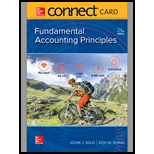
Concept Introduction:
Inventory- Inventory refers to the work in progress, raw material or the finished goods that are considered as the part of asset of business that are ready or would be ready to be sold.
Cost of goods sold-
Cost of goods sold (COGS) refers to the direct cost which is assigned to the cost of producing the goods sold. It includes cost of direct material ,labour used in the production of goods and services.
Net Income- Net Income refers to the total earning of the company which is computed by undertaking revenues and making adjustment underlying the cost for interest, doing business, taxes, interest,
Current Assets- Current Assets refer to those which can be converted into cash within one year.
Equity- Equity refers to the stock which depicts the ownership of the investor.
To prepare:
Financial statement showing the necessary adjustments to correct the amounts.
Answer to Problem 6BPSB
(a)
| COGS | Year 1 | Year 2 | Year 3 |
| Reported | $207,200 | $213,800 | $197,030 |
| Adjustment | |||
| Year 1 error | 18,000 | (18,000) | |
| Year 2 error | (26,000) | 26,000 | |
| Corrected COGS | 225,200 | 169,800 | 223,030 |
(b)
| Net Income | Year 1 | Year 2 | Year 3 |
| Reported | 175,800 | 212,270 | 184,910 |
| Adjustment | |||
| Year 1 error | (18,000) | 18,000 | |
| Year 2 error | 26,000 | (26,000) | |
| Corrected Net income | 157,800 | 256,270 | 158,910 |
(c)
| Current Asset | Year 1 | Year 2 | Year 3 |
| Reported | 276,000 | 277,500 | 272,950 |
| Adjustment | |||
| Year 1 error | (18,000) | ||
| Year 2 error | 26,000 | ||
| Corrected Current Asset | 258,000 | 303,500 | 272,950 |
(d)
| Equity | Year 1 | Year 2 | Year 3 |
| Reported | 314,000 | 315,000 | 346,000 |
| Adjustment | |||
| Year 1 error | (18,000) | ||
| Year 2 error | 26,000 | ||
| Corrected Equity | 296,000 | 341,000 | 346,000 |
Explanation of Solution
Corrected figures are explained as follows:
- Corrected COGS is ascertained by adding the overstated amount in year 1 and subtracting in year 2 and subtracting the understated amount in year 2 and adding in year 3.
- Corrected Net Income is ascertained by subtracting the overstated amount in year 1 and adding in year 2 and adding the understated amount in year 2 and subtracting in year3.
- Corrected Current Asset is ascertained by subtracting the overstated amount in year 1 and adding the understated amount in year 2.
- Corrected Equity is ascertained by subtracting the overstated amount in year 1 and adding the understated amount in year 2.
Year1-
Year2-
Year 3-
Year1-
Year2-
Year 3-
Year1-
Year2-
Year1-
Year2-
Conclusion:
Thus table showing the necessary adjustments to correct the reported amount is prepared.
Concept Introduction:
Inventory- Inventory refers to the work in progress, raw material or the finished goods that are considered as the part of asset of business that are ready or would be ready to be sold.
Net Income- Net Income refers to the total earning of the company which is computed by undertaking revenues and making adjustment underlying the cost for interest, doing business, taxes, interest, depreciation etc.
To calculate:
Computation of the error in total net income for combined three year period resulting from inventory errors.
Answer to Problem 6BPSB
The total Net income pertaining to period for three years is $572,980.
Explanation of Solution
The total Net Income is computed by adding the three years Net Income as:
Before error:
After Error:
Hence total income of three years is not affected by errors because such errors are self correcting as every overstated income is automatically offset by the matching understatement in the subsequent year.
Conclusion:
Hence the total net income for three years is computed.
Want to see more full solutions like this?
Chapter 6 Solutions
Connect Access Card For Fundamental Accounting Principles

 AccountingAccountingISBN:9781337272094Author:WARREN, Carl S., Reeve, James M., Duchac, Jonathan E.Publisher:Cengage Learning,
AccountingAccountingISBN:9781337272094Author:WARREN, Carl S., Reeve, James M., Duchac, Jonathan E.Publisher:Cengage Learning, Accounting Information SystemsAccountingISBN:9781337619202Author:Hall, James A.Publisher:Cengage Learning,
Accounting Information SystemsAccountingISBN:9781337619202Author:Hall, James A.Publisher:Cengage Learning, Horngren's Cost Accounting: A Managerial Emphasis...AccountingISBN:9780134475585Author:Srikant M. Datar, Madhav V. RajanPublisher:PEARSON
Horngren's Cost Accounting: A Managerial Emphasis...AccountingISBN:9780134475585Author:Srikant M. Datar, Madhav V. RajanPublisher:PEARSON Intermediate AccountingAccountingISBN:9781259722660Author:J. David Spiceland, Mark W. Nelson, Wayne M ThomasPublisher:McGraw-Hill Education
Intermediate AccountingAccountingISBN:9781259722660Author:J. David Spiceland, Mark W. Nelson, Wayne M ThomasPublisher:McGraw-Hill Education Financial and Managerial AccountingAccountingISBN:9781259726705Author:John J Wild, Ken W. Shaw, Barbara Chiappetta Fundamental Accounting PrinciplesPublisher:McGraw-Hill Education
Financial and Managerial AccountingAccountingISBN:9781259726705Author:John J Wild, Ken W. Shaw, Barbara Chiappetta Fundamental Accounting PrinciplesPublisher:McGraw-Hill Education





